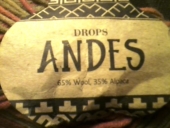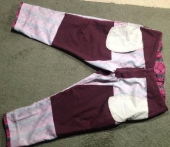
 12
12




Sourdough Without Fail Natural Small Batch Cheesemaking A Year in an Off-Grid Kitchen Backyard Dairy Goats My website @NourishingPermaculture @KateDownham






 4
4




Sourdough Without Fail Natural Small Batch Cheesemaking A Year in an Off-Grid Kitchen Backyard Dairy Goats My website @NourishingPermaculture @KateDownham






 7
7




 5
5




Invasive plants are Earth's way of insisting we notice her medicines. Stephen Herrod Buhner
Everyone learns what works by learning what doesn't work. Stephen Herrod Buhner
 6
6




 9
9





 6
6




How Permies works: https://permies.com/wiki/34193/permies-works-links-threads
My projects on Skye: The tree field, Growing and landracing, perennial polycultures, "Don't dream it - be it! "
 6
6




Trying to achieve self-reliance on a tiny suburban plot: http://gardenofgaladriel.blogspot.com
 7
7




My son wears T-shirts regularly. Many are now labelled "summer weight", He was shopping on-line and I suggested he look and see what the shipping weights were, and he actually found a site which labeled different versions as "2 pound cotton" etc. We got the heavy weight ones and they've lasted much better.Nancy Reading wrote: I suspect that the fabric is becoming lighter weight and therefore the threads get worn more quickly.
Visit Redhawk's soil series: https://permies.com/wiki/redhawk-soil
How permies.com works: https://permies.com/wiki/34193/permies-works-links-threads
 5
5




Nancy Reading wrote:I'm starting to become less of a fan of jersey cotton material, despite it having massive advantages in terms of comfort clothes. The stretch means nightclothes for example don't feel tight as you move in bed. I just think the material is harder to mend and retain the stretch, and somehow it seems to be needing to be mended sooner these days. I suspect that the fabric is becoming lighter weight and therefore the threads get worn more quickly. I find woven material to be much easier to mend and less likely to need it extensively.
Sourdough Without Fail Natural Small Batch Cheesemaking A Year in an Off-Grid Kitchen Backyard Dairy Goats My website @NourishingPermaculture @KateDownham






 6
6




Jay Angler wrote:
My son wears T-shirts regularly. Many are now labelled "summer weight", He was shopping on-line and I suggested he look and see what the shipping weights were, and he actually found a site which labeled different versions as "2 pound cotton" etc. We got the heavy weight ones and they've lasted much better.Nancy Reading wrote: I suspect that the fabric is becoming lighter weight and therefore the threads get worn more quickly.
...)
Country oriented nerd with primary interests in alternate energy in particular solar. Dabble in gardening, trees, cob, soil building and a host of others.
 5
5




 10
10




Zone 6, 45 inches precipitation, hard clay soil




 12
12




 2
2




 9
9




Gary Sandahl wrote:Does anyone have any experience with hemp fiber clothing?
"How fleeting are all human passions compared with the massive continuity of ducks.“ — Dorothy L. Sayers
 9
9




Kate Downham wrote:The linen skirt that I made with an elastic waist got holes quite quickly where the elastic was, but a linen wrap skirt I have is still looking great after two years. The wrap skirt is made from a heavier weight linen, but I suspect that the elastic on the other skirt may have irritated the linen fibres somehow, which could also explain it.
Does mixing up different fibres this way cause the natural one to wear out more quickly?
Best luck: satisfaction
Greatest curse, greed
 6
6




If you're sewing your own pants, or have worn out pants of the same fabric, may I suggest that you put a patch that is like a wide gusset so the seams aren't between the legs, but towards the front and back, but sewn so that it looks intentional *before* the pants are even worn? That way, the "patch" will wear out first (hopefully) and can be replaced possibly 2 or 3 times, before the next likely wear location is dead?Mercy Pergande wrote:I do wish I could find a way to preserve the inner thighs of my jeans from rubbing holes through. It doesn't matter how high quality or how well fitted, with the amount I walk, the physics of friction wins (and the seams from patching attempts make the whole situation worse!)
Visit Redhawk's soil series: https://permies.com/wiki/redhawk-soil
How permies.com works: https://permies.com/wiki/34193/permies-works-links-threads
 3
3




Gary Sandahl wrote:Does anyone have any experience with hemp fiber clothing?
"Also, just as you want men to do to you, do the same way to them" (Luke 6:31)






 5
5




"Also, just as you want men to do to you, do the same way to them" (Luke 6:31)
 6
6




Thekla McDaniels wrote:
Kate Downham wrote:The linen skirt that I made with an elastic waist got holes quite quickly where the elastic was, but a linen wrap skirt I have is still looking great after two years. The wrap skirt is made from a heavier weight linen, but I suspect that the elastic on the other skirt may have irritated the linen fibres somehow, which could also explain it.
Does mixing up different fibres this way cause the natural one to wear out more quickly?
Hi Kate,
I don’t know exactly, but I am imagining a piece of elastic running down a tube of fabric causing gathering. A contributing factor on the elastic linen situation might have been that the elastic - once in place - concentrated the abrasion on specific spots…. once’s gathered, the little folds in the cloth that makes the gathers don’t seem to shift and reorganize. Secondly, the elastic compresses the linen cloth against the body, increasing abrasion…
A wrap skirt is more likely to not put stress on the fibers, not compress some areas more than others against moving parts, and more easily slide over the body with movement.
Some of my guidelines on durable clothing: tight is going to wear out faster, and to me, is less comfortable.
In knit sweaters larger loops are going to be more vulnerable to snagging.
I wear a lot of cotton, but wool is a much stronger fiber. I think woven wool is stronger than knit wool.
Layers are good,
Thanks for starting the discussion
"The only thing...more expensive than education is ignorance."~Ben Franklin. "We can easily forgive a child who is afraid of the dark; the real tragedy of life is when men are afraid of the light." ~ Plato
 7
7




"The only thing...more expensive than education is ignorance."~Ben Franklin. "We can easily forgive a child who is afraid of the dark; the real tragedy of life is when men are afraid of the light." ~ Plato
 9
9




Kate Downham wrote:In wool clothing, either wool to knit with, or clothes that are already knitted, is there anything to look for to decide whether it is made for long life?
Sometimes activism is chaining yourself to a bulldozer or blockading parliament. Far more often, it’s growing too many zucchinis and sharing them with your neighbours.






 9
9




Hooray for Homesteading!
 13
13




 5
5




Imogen Skye wrote:I have lengthened the life of merino base layers using traditional Japanese Sashiko, which I love and highly recommend for clothing repairs- very effective and looks lovely if you enjoy the [shabby-chic] aesthetic.
Sourdough Without Fail Natural Small Batch Cheesemaking A Year in an Off-Grid Kitchen Backyard Dairy Goats My website @NourishingPermaculture @KateDownham






 11
11




 4
4




 9
9




All true wealth is biological.
Lois McMaster Bujold
 5
5




Dian Green wrote:I will preface my response that I am: cheap, tall, fat, allergic to wool and have sensory issues with some textures.
The result is that clothes have always been a challenge. I've thrifted my clothing all my adult life and over the past few decades, have gotten more extreme in terms of modifying, remaking and constructing from scratch.
Consistently, men's clothing from several higher end designers/manufacturers that were made in the 80's and 90's tend to be the highest quality and best wearing stuff I have. I'm also typically going for cottons and linens since those are washable and work for my comfort.
I have found that it can be amazing how much of a difference in comfort, wearability and function, a few small modifications can make to your clothes. Due to the severity of my requirements, if I didn't take stuff that was 75%+ of what I was looking for, I wouldn't have anything. I'll often pick up things that are close, but not quite right. With a few tweaks they can still work. Too tight? Add a gusset or open the bottom of a seam. It gaps between buttons? Sew it closed and leave enough so it can be a pullover. Sleeves too long? Cut them off and move up the cuff.
Figuring out what works for you, how you wear things, will let you modify in the ways that reduce the wear on your things and let you make the best quality finds work.
For designing from scratch, I started with my favourite pieces and thought about why they were the best and then used them to make patterns for new pieces. A few years ago, I also made a dummy of my body with shipping tape and expanding foam. That has been a total game changer and she makes it super easy for me to both fit things and see how they look!
Best luck: satisfaction
Greatest curse, greed
 2
2




Thekla McDaniels wrote:Holy Cow, Dian
Thanks for posting all this!
I haven’t worn clothes that fit, other than jeans and tee shirts in decades. I have a small-ish rib cage and large bust. Mass produced clothes don’t fit me. And most women’s clothes are designed to accentuate not minimize the bust. Even when I was young and beautiful, I did not enjoy the sexual overtures generated in response to my figure, let alone seek to invite them. How my body looks is definitely not the most important thing about me, nor what I want to be known for!
I’ve thought I needed a dressmaker form so I could make from scratch and remake thrift store finds for a long time, but NEVER had the idea of making my own. That’s BRILLIANT!
I’m lousy at guesstimating how to alter a pattern or garment, and I have a feeling the foam and tape body double is really going to be a game changer for me. Thank you!
"The only thing...more expensive than education is ignorance."~Ben Franklin. "We can easily forgive a child who is afraid of the dark; the real tragedy of life is when men are afraid of the light." ~ Plato
 4
4




Best luck: satisfaction
Greatest curse, greed
 5
5




All true wealth is biological.
Lois McMaster Bujold

| I agree. Here's the link: http://stoves2.com |




